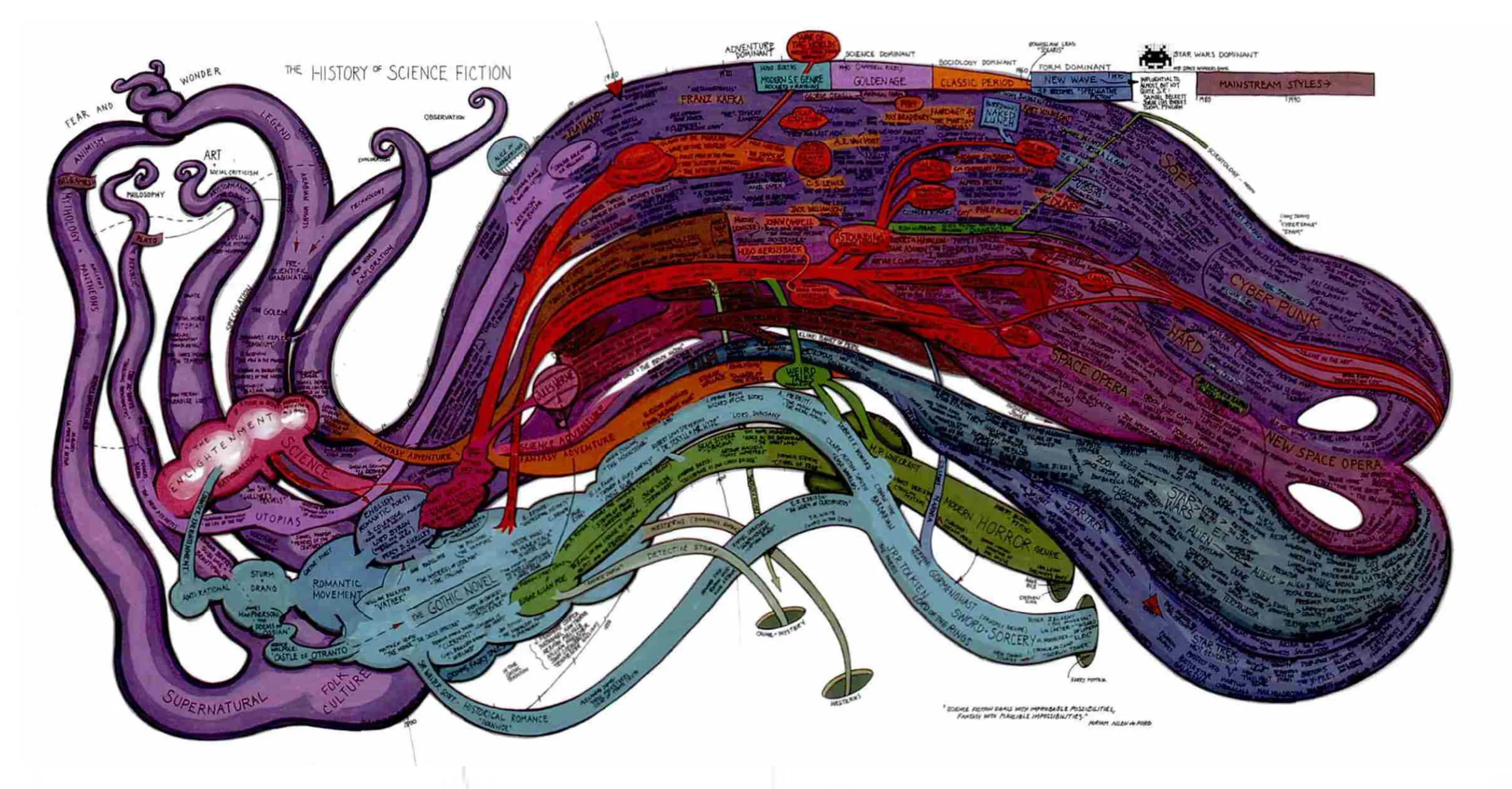废体存用──Ward Shelley跨界创作的知识论背景
2013-10-23欧阳琦WardShelley
(文)欧阳琦(图)WardShelley

One of the more extreme effects of modern life is a sence of extreme individualism,which can be experienced as separation from history, from society, from each other,and ultimately, from ourselves. Another effect of this sence of separation is the widely discussed idea of transgressing disciplinary, genre, and media boundaries to create "new" art and research. Nevertheless, despite all this artistic and intellectual cross-pollination, it has become clear that simply hyphenating one's practice (artistethnographer, for example)does not necessarily lead to the creation of relevant work. And that, after all, is the goal of transgressing established boundaries -- artists and intellectuals aim to create perspectives that help us better understand the worlds in which we live.
Ward Shelley's work defies easy catagorization because he easily crosses boundaries of all kinds, creating perspectives that resonate with contemporary experience. "A-ha," we think when first encountering a piece from his series Unreliable Narrator, "this is how history should be told." In Just Cause, for example,Shelley represents American history as a sepertine chain of righteous wars and their unjust causes. This history begins with colonial occupations and slithers through the Indian Wars, the American Revolution, World Wars I and II, Korea and Vietnam,until it slides of f the page into the future. History of Science Fiction more explicitly narrates the organic coevolution of genre and perspective. The composition of the painting allows the viewer to read history as either the unfolding of a genre over time(reading the image from left to right)or as organically interdependent events (reading the image from top to bottom).
Shelley's collaboration with performance-architecture artist, Alex Schweder La further illustrates how relevant art does not simply cross boundaries, but rather makes salient our coevolutionary histories. In Counterweight Roommate, Shelley and Schweder La constructed a f ve-story building. Each f oor had a specif c function-- bathroom on the f rst f oor, bedroom on the second, common space on the third,another bedroom on the fourth, and the kitchen on the f fth. And here's the beauty of the design: Shelley and Scheder La roped themselves together, concretely illustrating social interdependency. For one roommate to use the bathroom, the other had to scale the wall to the kitchen. Likewise, if one wanted personal time in his room, the other also had to go to his room. The piece crosses all sorts of boundaries-- anthropology, urban planning, performance and installation art, and architecture-- to make its most relevant point: we only think we live isolated, independent lives.But the reality is that f ushing a toilet or going to bed has reprocussions we have not yet learned to imagine.
跨界——如今成了艺术界的时尚,仿佛没有跨界的作品和创作就难当艺术家的称号。于是一批画画的开始盖房子,盖房子的开始演戏,演戏的开始写诗,写诗的去玩音乐,音乐人搞体育,而世界冠军又投身新媒体。总之,不甘心一辈子在一种专业里闷死自己。但是“跨界”跨了什么?“跨界”到底带给我们什么“新东西”?跨界究竟怎样跨才能带来“新视野”?以及为什么要做这样而不是那样的“跨界”?这件事好像没能得到很清晰的反省,至少在我们中国的艺术界和知识界。
WardShelley最近的两组作品,可能对这个“跨”字给了一个很刺激的刺激!首先用图像学打通知识论,这可以看作是跨界思维。其次表达上具体直观,这可以看作跨界的得意废言。前者是思想过程,后者是表达过程。但是细究之下,真的如此轻易?
他的第一组作品叫做“不稳定的叙述人”。他尝试用一种类似人类或动物内脏的解剖图像来建构他的历史学叙事。在他好奇的历史学主题中有美国的殖民史图谱,其形象颇似一条血红的发了炎的盲肠或是肠子里愤怒的蛔虫,这个殖民史的内容则是一场接一场的战争。他为这个作品取名叫“合情理的正义事业”。在这条肠子的上方和下方都有像标尺一样划分出的时代,酷似一个生物进化标本的时间记录。它开始于欧洲人殖民美洲,而到今天这个过程还在继续。肠子或者虫子的每一节都吸附在壁腔上,大口吞食着机体的营养,同时给出战争的各种借口,比如:1893年美军占领夏威夷王国,借口是“保护美国人的甘蔗农场”。1917-1918年美国介入一战的借口是“向世界推广民主”,而它想要获得的真正利益是确保英法不输给德奥,这样美国借给英法的钱才不会打水漂。再比如:1950-1953韩战,借口是“抵制邪恶力量扑灭民主火焰”,而美国的利益是希望通过朝鲜的亚洲人攻击社会主义阵营。而10年后在越南再次点燃了这个“正义事业”的火海。另一个历史学的主题是“科幻”。在这个图像历史学里,他把绘画的潜力发挥到知识论的极限,不仅形象的给出“科幻文学史”清晰结构,甚至给出了某种兼有谱系学和地理学特征的地图。在这幅色彩斑斓的地图上,他把“科幻文学”这个当代美国最流行的大众文化产品,从起源到文类、品级再到风格、流派以及单独作品和作家的影响脉络,用一个类似消化系统的图例加以表现。同时给出进化标尺。这个作品让我们真正摆脱了阅读历史时一贯的线性思维,而建立起空间上的文化场感知。举个例子,在这个作品中你能清晰地看到一个个历史上著名作品的显赫位置,比如:玛丽·雪莱和她的《弗兰根斯坦》。玛丽象一股疝气从她的那一堆浪漫主义诗人的多愁善感中异军突起地爆出来,可以说是横空出世艺压群雄,占据了她那个时代的一大块文学空间。如果你好奇这样一个怪胎从哪里来的?你可以在它问世之前看到,有关恐惧与好奇的传统在西方文学、哲学和民间信仰中大量存在与流行各种文本。而假如你关心这个作品的成功又怎样影响了未来的作品诞生?那么你会发现两个直系亲属——儒勒·凡尔纳的《海底两万里》和更远一些的H·G威尔斯的《时间机器》。而如果你留意她同时代的作家和作品,则会发现“浪漫主义”和“哥特文学”并存,而在美国也是这两股文学潮流造就了类似的作家爱伦·坡。在这个地图中还会看见一种非常有趣的现象就是某种文类或风格会在独霸一段时间之后莫名地消失在历史的一个地洞里再没出现过,就像有机体的排泄物排到体外。一种复调式的文学史和思想史就这样被形象的建立起来了。而这个知识论最明显的特征之一就是强调时间、空间、人物、事件、文化氛围等诸作用的相互影响和相互渗透而非简单的历史决定论。
这样一个图像学的知识论再一次被用于“跨界”,是在2011年瑞士巴塞尔的一个展览上。事情的缘起是Scope基金委托WardShelley和AlexSchweder,合作创作一个“有关社会关系的建筑”。这个作品后来被WardShelley命名为《平衡中的同居者》。他们事先做了一个塔式的建筑,高9.5米,一共5层每一层是一个透明房间,面积0.6x1.8米。这些房间的分布是一层卫生间,二层卧房,三层公共空间,四层卧房,顶层厨房。但是这些房子之间无论是内部还是外墙均无楼梯相通,必须要靠绳索才能从窗户攀爬进去。而当他们完成了这个建筑之后,两人决定搬进去住五天,最后完成他们的作品。而他们的做法是把自己的身体和另一个人的身体用绳索连起来。这样一个人想去任何一个地方,另一个人就必须相应的采取行动。比如:一个人要吃饭,另一个人就必须去厕所。一个人要睡觉,另一个人也要上床。一个人要聊天,另一个就得过来公共空间听着。这个作品在我看来也是一个图像学式的知识论表达。它把我们已经抽象了的人际关系具体化为一条绳索,每一个决定都会直接引起对方的反应。它打破了我们自以为是的幻觉,好像自由或独立的行为其后果都不会影响到其他人的存在。“社会关系”在这个作品里赤裸裸的表达为,当你想上厕所,就必须把对方从他甜睡的热被窝里拎出来,而且他同不同意都无关。因为事实就是如此。
再回想前面一个作品,是否也能在后面的作品中找到回音呢?好像也是有的,假如我们考虑文化,尤其是语言的作用,是不是像一条绳子一样绑架了我们呢?当然从另一方面说我们还不能没有这条绳子,除非我们发明了楼梯。有了楼梯,则多了一重选择的自由。但是我们如果还是需要楼梯,实际上和被绳子捆绑没有本质的区别,此时维特根斯坦的建议就弥足珍贵了:上了房子,推倒梯子。用中国古老的智慧说,叫做“得意忘言”。但这样的暗示能带来建筑上启发吗?最后弱弱地问一句,谁能知道跨界何为?但是我们每天都在跨……


